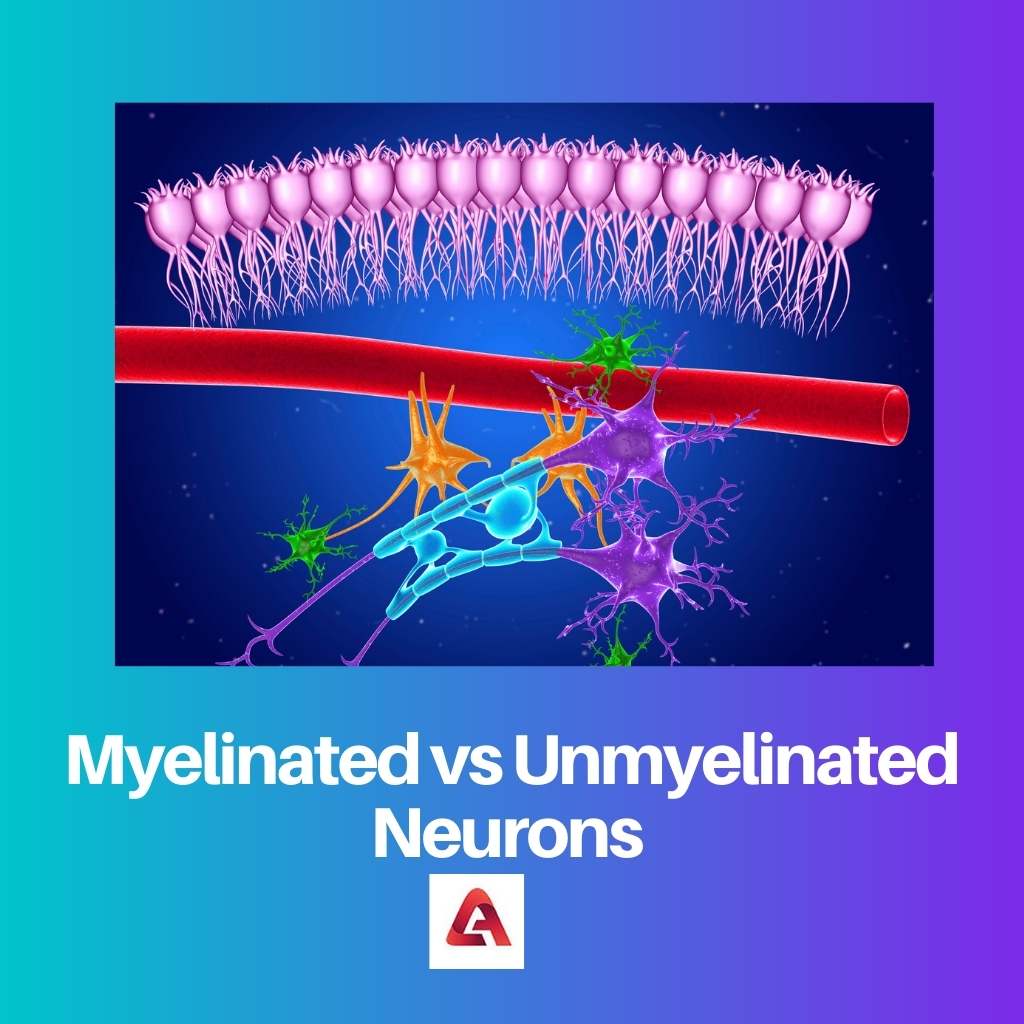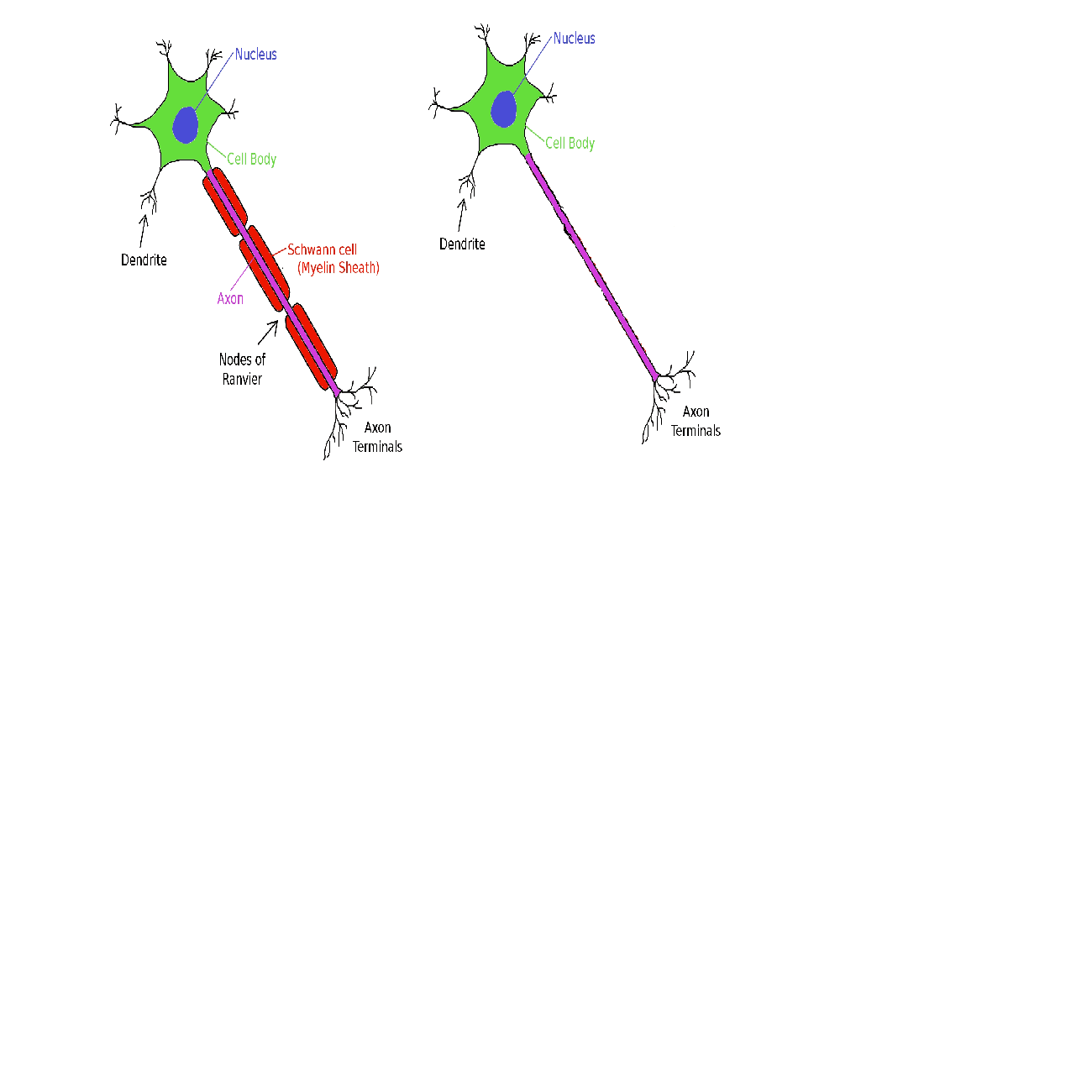Neurons play an inevitable function in the functioning of our bodily functions. Myelinated and unmyelinated neurons are a pair of neurons that perform the crucial function of transmitting and conducting electric signals across the body.
However, they have several differences in their appearance and functioning.
Key Takeaways
- Myelinated neurons have a myelin sheath, an insulating layer that covers the axon, improving the speed and efficiency of electrical signal transmission.
- Unmyelinated neurons lack a myelin sheath, resulting in slower signal transmission and less efficient communication between neurons.
- Myelinated neurons are essential for rapid signal transmission in the nervous system, while unmyelinated neurons play a role in slower, more modulated responses.
Myelinated vs Unmyelinated Neurons
Myelinated neurons have a fatty layer called myelin surrounding their axons, allowing for faster conduction of electrical signals, they are found in the peripheral and central nervous systems. Unmyelinated neurons lack this fatty layer and have slower conduction, and they are found in the autonomic nervous system.

Myelinated Neurons refer to a neuron wherein a layer of Schwann cell membranes encloses the axon. Myelinated neurons perform the function of transmitting signals from one part of the body to another.
Thus, they play a fundamental role in information transmission. Moreover, myelinated neurons mature at the age of two years in the brain.
Unmyelinated neurons are nerve cells with the primary potential to transmit impulses through electric signals. The Schwann cells are not wrapped around axons. Instead, the cells are arranged in the shape of a groove.
In addition, the unmyelinated fibers comprise both nonpeptidergic and peptidergic C-fibre axons.
Comparison Table
| Parameters of Comparison | Myelinated Neurons | Unmyelinated Neurons |
|---|---|---|
| Definition | Myelinated neurons comprise a myelin sheath surrounding the axon. | Unmyelinated neuron is devoid of any myelin sheath. |
| Conduction of Impulses | There is a faster transmission and conduction of electrical signals in the case of myelinated neurons. | There is a slower transmission and conduction of electrical impulses in the case of unmyelinated neurons. |
| Appearance | Myelinated neurons have a white appearance in a fresh state. | Unmyelinated neurons have a gray appearance in the fresh state. |
| Nodes and Internodes | Nodes and internodes are clearly visible in the myelinated neurons. | Nodes and internodes are absent in the unmyelinated neurons. |
| Found in | Myelinated neurons are found in the central nervous system and the cranial nervous system. | Unmyelinated neurons are found in the autonomic nervous system. |
What are Myelinated Neurons?
Myelinated Neurons refer to a neuron wherein the axon is enclosed by a layer of Schwann cell membranes, also known as a sheath. There are several advantages to the prevalence of a myelin sheath.
The most prominent advantage is the prevalence of faster conduction of action potential. Thus, messages are able to transfer at a faster pace.
The myelinated neurons are found in the peripheral nervous system and the white substances of the central nervous system.
Most importantly, the sensory and motor neurons are commonplace in the peripheral and central nervous systems. The myelin sheath also provides insulation and protection to the neurons.
The myelin formation occurs in the brain, spinal cord, and optic nerve by oligodendrocytes. Myelinated neurons perform the function of transmitting signals from one part of the body to another.
Thus, they play a fundamental role in information transmission. In addition, myelinated neurons comprise approximately 80% lipids.
Myelinated neurons mature at the age of two years in the brain. The Schwann cells are responsible for producing myelinated neurons for peripheral axons. However, it is the duty of oligodendrocytes to produce myelinated neurons for central axons.
To conclude, myelinated neurons have an edge over unmyelinated neurons due to the presence of the myelin sheath.

What are Unmyelinated Neurons?
Unmyelinated Neurons are those neurons devoid of a layer of the myelin sheath. Due to the absence of a myelin sheath, unmyelinated neurons are relatively slower in the transmission of signals from one part of the body to another.
Unmyelinated neurons are found in the gray matter of the nervous and peripheral nervous systems.
Unmyelinated neurons are also known as Type C neurons. The unmyelinated fibers comprise both nonpeptidergic and peptidergic C-fibre axons.
The location of unmyelinated neurons is the hairy and glabrous skin. Moreover, the axis cylinder of unmyelinated neurons consists of a singular sheath instead of multiple ones.
The color and appearance of unmyelinated neurons are gray at first appearance. The Schwann cells are not wrapped around axons. Instead, the cells are arranged in the shape of a groove.
In addition, unmyelinated neurons don’t have prominent nodes and internodes. The commonplace location of unmyelinated neurons is the autonomic nervous system.
Thus, unmyelinated neurons are nerve cells that have the primary potential to transmit impulses in the form of electric signals. The production of collateral fibers is absent in the case of unmyelinated nerve fibers.
However, the absence of unmyelinated neurons connotes a slower transmission and conduction of impulses.

Main Differences Between Myelinated and Unmyelinated Neurons
- Myelinated neurons comprise a myelin sheath surrounding the axon. On the other hand, an unmyelinated neuron is devoid of any myelin sheath.
- There is a faster transmission and conduction of electrical signals in the case of myelinated neurons as compared to unmyelinated neurons.
- Myelinated neurons have a white appearance in a fresh state. In contrast, unmyelinated neurons have a gray appearance in the fresh state.
- Nodes and internodes are clearly visible in the myelinated neurons. On the other hand, nodes, and internodes are absent in the unmyelinated neurons.
- Myelinated neurons are found in the central and cranial nervous systems. In contrast, unmyelinated neurons are found in the autonomic nervous system.
This article provides useful information about myelinated and unmyelinated neurons, shedding light on their distinct functions and characteristics. It’s a valuable resource for anyone interested in neuroscience.
This piece is very enlightening and makes me appreciate the complexity of our nervous system. It’s fascinating to learn about myelinated and unmyelinated neurons and the distinct roles they play in signal transmission.
The detailed descriptions and explanations in this article are exceptional. It’s a great read for those seeking a deeper understanding of myelinated and unmyelinated neurons.
The discussion of myelinated and unmyelinated neurons in this article is presented with great clarity and depth. It is a valuable resource for individuals studying neuroscience and related fields.
The comparative analysis of myelinated and unmyelinated neurons in this article is incredibly insightful. It’s important to understand how these neurons differ and the impact it has on signal conduction.
This article is a very well-written and informative piece that explains the differences between myelinated and unmyelinated neurons in great detail. It provides a very clear understanding of these important components of our nervous system.